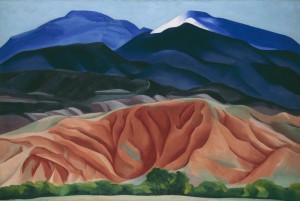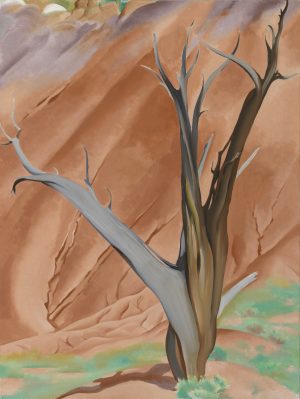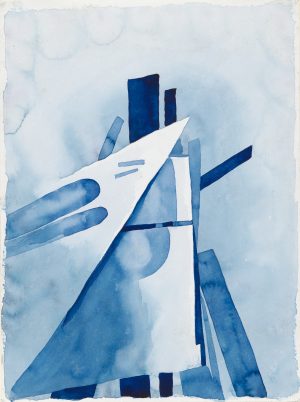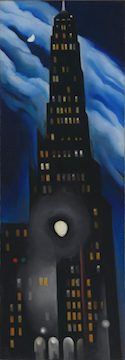Art Activities for All Ages
Break out the watercolors, colored pencils, or whatever you can get your hands on to try some of Georgia O’Keeffe’s artistic and compositional techniques. These activities are made for family fun and we promise that you won’t be graded.

Abstract Watercolors
The watercolors that Georgia O’Keeffe created while living and teaching in Texas show her dedication to abstraction. Abstraction explores the relationships between forms and colors, while more traditional art represents the world in recognizable images.

Art and Advertising
Georgia O’Keeffe was invited to Hawai‘i in 1939 to create advertising art for the Hawaiian Pineapple Company (now the Dole Company). Working with artists to produce ads and sell products was becoming popular at that time. Today, artists work to produce ads for television, the Web, and print media.

Bird’s-Eye View
A bird’s-eye view is an aerial perspective on an object or landscape as if observed from above by a bird. Georgia O’Keeffe made several paintings as bird’s-eye views, based on scenes she’d seen from airplane windows.

Cloud Painting
Georgia O’Keeffe once described the changing patterns and colors of clouds as “breathtaking.” She loved looking down at clouds from airplane windows and looking up at them while standing on the ground. O’Keeffe made several paintings of clouds.

Color
“I found I could say things with color and shapes that I couldn’t say any other way—things I had no words for.”
—Georgia O’Keeffe

Color Me O’Keeffe!
“Color is one of the great things in the world that makes life worth living to me.”
– Georgia O’Keeffe
Express yourself creatively through these O’Keeffe-inspired coloring pages

Color Me O’Keeffe!
In 1912, Georgia O’Keeffe was introduced to an important book of exercises titled Composition, by Arthur Wesley Dow. She was a student at the University of Virginia at this time and used Dow’s ideas of art structure to form her own style of art. O’Keeffe remained dedicated to drawing throughout her life, creating hundreds of drawings.
Be inspired by the art exercises O’Keeffe would have practiced, and have some fun with landscapes

Drawing Exercises
Let’s have fun with different ways of drawing and seeing!
Try three different drawing techniques to experiment with composition and perspective

Drawing Trees
“I wish people were all trees and then I think I could enjoy them.” —Georgia O’Keeffe

Friends and Family Tree
Explore creative techniques for creating your own tree of your friends and family. Use colored pencils, magazine images, or your own images. Glue or draw on to the tree things that best represent your family and friends!

Make a Zine
Did you know that Georgia O’Keeffe LOVED books? We hope you do to! Let’s celebrate books by designing our own art book or zine!

Nature Souvenirs
Georgia O’Keeffe loved nature and she loved to travel! She collected many different natural objects from her adventures. Rocks, bones, feathers, and shells were some of her favorite things to collect and be inspired by.
Take a look at some of these works O’Keeffe created and how she kept her souvenirs

Notan
Notan is a Japanese word meaning the balance between dark and light. It is the design or pattern of a work of art as seen in flat areas of dark and light values only. Georgia O’Keeffe utilized the principles of notan in her compositions, which can be especially understood when looking at her drawings.
To practice notan, grab a sketchbook and choose a subject to focus on

Photography
Hundreds of photographs of Georgia O’Keeffe were taken throughout her life, and each one reveals something of her character. Her husband, Alfred Stieglitz, was a pioneer
of photography, and their friends included many famous photographers, such as Ansel Adams and Todd Webb.
Think of someone you are close to, and try to capture their personality in five photographs

Photography Viewfinder
Most cameras have a viewfinder—a small square of glass that you look through to compose or focus the subject of what will be included in the photograph.
Make your own paper viewfinder to create different compositions in the world around you

Pioneer of Process
Georgia O’Keeffe didn’t always paint flowers. Like many artists, O’Keeffe experimented with different techniques in order to find her own unique style.

Positive and Negative Space
The composition of a work of art is determined by the use of positive and negative space. Positive space is the area that is the focus or subject of the artwork. The negative space is the area around the main subjects.
Take a closer look at this concept and then create your own composition

Rule of Thirds
The rule of thirds is a guideline commonly used in painting, photography, and design. The rule of thirds means that the subject isn’t centered; rather, the main focal point can be to one side or at the top or bottom of the image. It’s a tool to help artists draw the viewer’s eye into the composition, rather than just glancing at the center.

Viewfinder
A viewfinder is a tool that some artists look through to compose, and in many cases to focus, a picture. It makes possible the close examination of a potential composition from various viewpoints and can be used for portraits, figures, landscapes, or any other subjects.

What’s Outside Your Window?
Georgia O’Keeffe was inspired by the beauty of the New Mexico desert. From her bedroom window in Abiquiu, she could see the vast sky above, hills and trees below, and a road stretching into the distance.